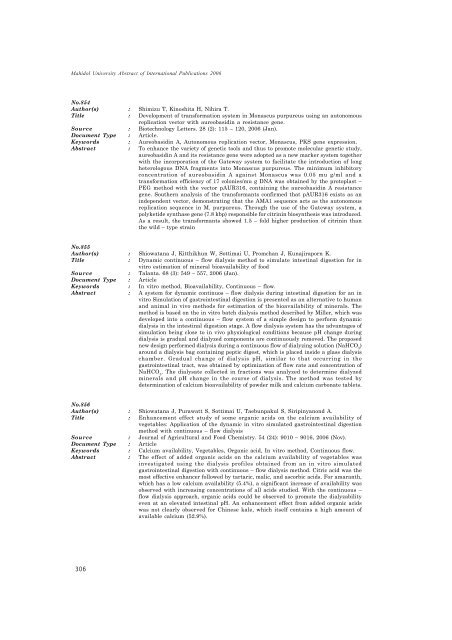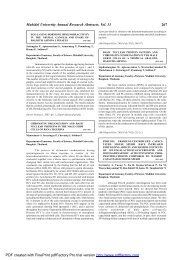2006 ที่น้องแอนทำ.pmd - Mahidol University
2006 ที่น้องแอนทำ.pmd - Mahidol University
2006 ที่น้องแอนทำ.pmd - Mahidol University
Create successful ePaper yourself
Turn your PDF publications into a flip-book with our unique Google optimized e-Paper software.
<strong>Mahidol</strong> <strong>University</strong> Abstract of International Publications <strong>2006</strong><br />
No.854<br />
Author(s) : Shimizu T, Kinoshita H, Nihira T.<br />
Title : Development of transformation system in Monascus purpureus using an autonomous<br />
replication vector with aureobasidin a resistance gene.<br />
Source : Biotechnology Letters. 28 (2): 115 – 120, <strong>2006</strong> (Jan).<br />
Document Type : Article.<br />
Keywords : Aureobasidin A, Autonomous replication vector, Monascus, PKS gene expression.<br />
Abstract : To enhance the variety of genetic tools and thus to promote molecular genetic study,<br />
aureobasidin A and its resistance gene were adopted as a new marker system together<br />
with the incorporation of the Gateway system to facilitate the introduction of long<br />
heterologous DNA fragments into Monascus purpureus. The minimum inhibitory<br />
concentration of aureobasidin A against Monascus was 0.05 mu g/ml and a<br />
transformation efficiency of 17 colonies/mu g DNA was obtained by the protoplast –<br />
PEG method with the vector pAUR316, containing the aureobasidin A resistance<br />
gene. Southern analysis of the transformants confirmed that pAUR316 exists as an<br />
independent vector, demonstrating that the AMA1 sequence acts as the autonomous<br />
replication sequence in M. purpureus. Through the use of the Gateway system, a<br />
polyketide synthase gene (7.8 kbp) responsible for citrinin biosynthesis was introduced.<br />
As a result, the transformants showed 1.5 – fold higher production of citrinin than<br />
the wild – type strain<br />
No.855<br />
Author(s) : Shiowatana J, Kitthikhun W, Sottimai U, Promchan J, Kunajiraporn K.<br />
Title : Dynamic continuous – flow dialysis method to simulate intestinal digestion for in<br />
vitro estimation of mineral bioavailability of food<br />
Source : Talanta. 68 (3): 549 – 557, <strong>2006</strong> (Jan).<br />
Document Type : Article<br />
Keywords : In vitro method, Bioavailability, Continuous – flow.<br />
Abstract : A system for dynamic continuos – flow dialysis during intestinal digestion for an in<br />
vitro Simulation of gastrointestinal digestion is presented as an alternative to human<br />
and animal in vivo methods for estimation of the bioavailability of minerals. The<br />
method is based on the in vitro batch dialysis method described by Miller, which was<br />
developed into a continuous – flow system of a simple design to perform dynamic<br />
dialysis in the intestinal digestion stage. A flow dialysis system has the advantages of<br />
simulation being close to in vivo physiological conditions because pH change during<br />
dialysis is gradual and dialyzed components are continuously removed. The proposed<br />
new design performed dialysis during a continuous flow of dialyzing solution (NaHCO 3 )<br />
around a dialysis bag containing peptic digest, which is placed inside a glass dialysis<br />
chamber. Gradual change of dialysis pH, similar to that occurring in the<br />
gastrointestinal tract, was obtained by optimization of flow rate and concentration of<br />
NaHCO 3 . The dialysate collected in fractions was analyzed to determine dialyzed<br />
minerals and pH change in the course of dialysis. The method was tested by<br />
determination of calcium bioavailability of powder milk and calcium carbonate tablets.<br />
No.856<br />
Author(s) : Shiowatana J, Purawatt S, Sottimai U, Taebunpakul S, Siripinyanond A.<br />
Title : Enhancement effect study of some organic acids on the calcium availability of<br />
vegetables: Application of the dynamic in vitro simulated gastrointestinal digestion<br />
method with continuous – flow dialysis<br />
Source : Journal of Agricultural and Food Chemistry. 54 (24): 9010 – 9016, <strong>2006</strong> (Nov).<br />
Document Type : Article<br />
Keywords : Calcium availability, Vegetables, Organic acid, In vitro method, Continuous flow.<br />
Abstract : The effect of added organic acids on the calcium availability of vegetables was<br />
investigated using the dialysis profiles obtained from an in vitro simulated<br />
gastrointestinal digestion with continuous – flow dialysis method. Citric acid was the<br />
most effective enhancer followed by tartaric, malic, and ascorbic acids. For amaranth,<br />
which has a low calcium availability (5.4%), a significant increase of availability was<br />
observed with increasing concentrations of all acids studied. With the continuous –<br />
flow dialysis approach, organic acids could be observed to promote the dialyzability<br />
even at an elevated intestinal pH. An enhancement effect from added organic acids<br />
was not clearly observed for Chinese kale, which itself contains a high amount of<br />
available calcium (52.9%).<br />
306
















